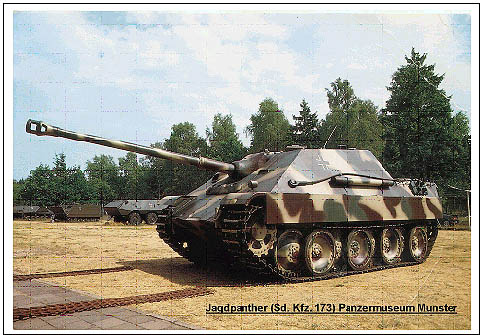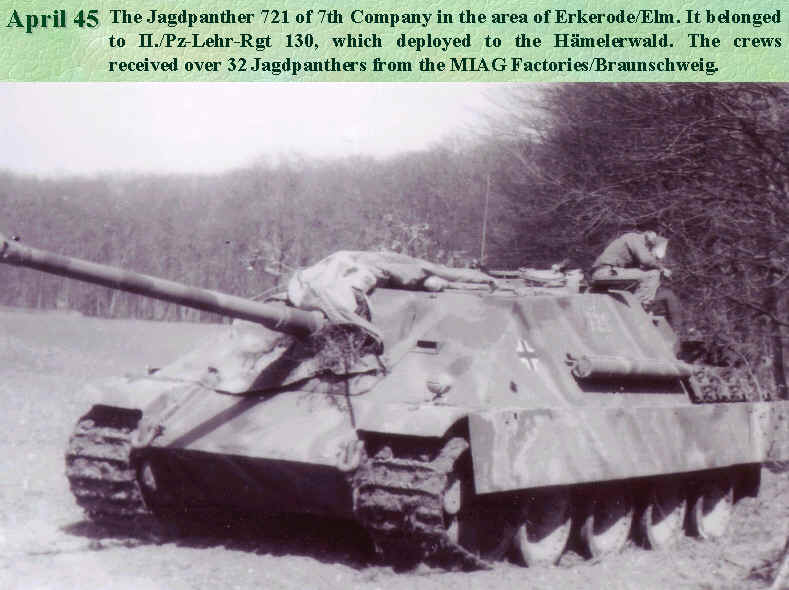
In April 1945, as the noose tightened around the German units on the Rhine and Ruhr rivers, available American and British troops pushed vigorously toward the River Elbe. The objective was to prevent German units from setting up an organized defense on the Weser River. Our area was occupied by the 9th (US) Army. One of its spearheads was the 5th (US) Armored Division. The British attacked north of a line running from Minden to Celle.
On 3 April 1945, first elements of the 5th (US) Armored Division reached the Weser River south of the town of Minden. Now they only had to find an intact crossing site, if possible the autobahn (highway) bridge near Vennebeck in order to drive for Hanover from there. This plan however, failed as the bridge had been blown up somewhat earlier as British troops entered Minden.
As the next day still had not brought success, a crossing was to be forced near Minden on 5 April. For this purpose, the 84th (US) Infantry Division moved up forces until nightfall, but this attempt in the area of Porta Westfalica had to be abandoned due to stiff enemy resistance. As a result, the commanding XIIIth (US) Corps decided to postpone the crossing to 6 April.
In the meantime, the forces of the 5 (US) Armored Division had gathered in the Herford - Bad Oeynhausen - Rinteln area. Secured by roadblocks and reconnaissance patrols, the division started to comb through the area, netting a large number of German soldiers and other civilian refugees. In addition to these activities, the division was preparing to provide personnel and materiel support to the crossing by the 84 (US) Infantry Division. However, this was not to materialize. In the meantime, the right-hand neighbor, the 2nd (US) Armored Division assisted by the 30th (US) Infantry Division, had forced a crossing near Hameln and started to build an emergency bridge as a prelude to the drive for Hildesheim.
As a result of this development, the 5th (US) Armored Division was diverted on 8 April and ordered to quickly cross the bridge near Hameln. First the Combat Command Reserve was ordered to leave the Rinteln area and march to Hameln. This was out of the ordinary as Hameln was located in the area of responsibility of the XIXth (US) Corps and to reach it a wide southward turn was required. As so often, the order surprised the troops. Subsequently, a northward turn would be required again to reach the area around Gestorf south of Hanover. The Combat Command Reserve (similar to a modern-day manoeuver brigade) was to cross the bridge between 1400 and 1900 hours. When the order arrived, it was already noon. Thus, the Combat Command Reserve had only a few minutes in which to take the lead and start out on its roughly 60 - 80 km move. At 2130 the entire Combat Command Reserve (CC R) had reached the Springe - Gestorf area and was thus back in the zone of operations of its parent XIII Corps. There was some stiff resistance in Springe, which was reduced by the reinforced 10th (US) Tank Battalion, clearing the way to crossings over the Leine River near Ruthe and Koldingen.
On 9 April, the attack was continued at 0730 hours. Reconnaissance forces quickly pushed towards the crossings and reported their seizure in less than an hour. Now
the Combat Command Reserve (CC R) was able to follow up immediately and attack in the direction of Lehrte in order to cut the important lines of communications east of Hanover. Nothing seemed to jeopardize this endeavor until the leading units, the 47th (US) Armored Infantry Battalion (Task Force Boyer) on the left and the 10th (US) Tank Battalion (Task Force Hamberg) on the right, reached the Mittelland canal north of Müllingen. They were less than 100 yards away when the bridges blew up. When the lead elements came under heavy artillery fire and friendly close air support failed to materialize due to cloudy weather, the attack bogged down. In general the resistance around Hanover seemed to be growing.
At this point, the right-hand neighbor, again the 2 (US) Armored Division suggested bypassing the enemy to the south in order to cut the road network west of Peine. Earlier, the division commander, Major General Lunsford E. Oliver, had visited the command post of Combat Command Reserve (CC R) near Rethen to discuss the further course of action. The southern route of march was identified quickly since the only road with an adequate capacity to accommodate the forces of an entire division ran from Harsum - Hohenhameln - Rosenthal to Vöhrum. In the meantime, the engineers of 2 (US) Armored Division installed bridging equipment on the Hildesheim branch canal near Harsum, creating the conditions for even heavy tracked vehicles to cross. Thus, the reinforced 10th (US) Tank Battalion only had to turn south and subsequently attack toward the north-east. According to the available reports, the further march of the Combat Command Reserve went according to plan.
Only in the Equord - Schwicheldt area, when lead elements had already passed Rosenthal in the direction of the autobahn (highway) near Vöhrum - Eixe, a firefight between German tank destroyers (of the "Panther" variant) and the following companies developed. At least four German tank destroyers were identified and forced to withdraw with the assistance of the American air forces. The report by the 10th (US) Tank Battalion states that one "Panther" tank destroyer was hit in the tracks and was set on fire by its crew. In Schwicheldt another "Panther" tank destroyer is reported to have been abandoned as a result of the air attacks and was captured by elements of C Company.
In advance of this action, the "Panther" tank destroyers had deployed from Braunschweig to the Härmelerwald woods (Hämelerwald) where they took cover. Apparently, this detachment had orders to delay the advancing Americans and withdraw to the Oker River. This plan was obviously made without consideration of the American air forces. As soon as the skies had cleared the Germans were unable to hold any longer. Peine lay unprotected and the American move had brought it into the line of fire. Low-flying aircraft flow strafing missions everywhere. What everybody had been fearing for days and weeks was a reality now. The Burgermeister of Peine sought a quick surrender of the town, which accommodated three large military hospitals. By contacting A Company of the leading reinforced 10th (US) Tank Battalion he opened negotiations, which ended the next day with the surrender of the city and the Americans continued to pursue their original objective. The autobahn (highway) near Eixe and Vöhrum was cut that same evening and they succeeded in holding the area around Rosenthal and Schwicheldt. What is more, Rosenthal even had to accommodate the command post of the advance unit for the night; and all access points were secured. Further to the south, contact was established with elements of the 2nd (US) Armored Division and the 30th (US) Infantry Division, which were part of the right-hand neighbor, the XIXth (US) Corps. Braunschweig, Salzgitter and Magdeburg were their next objectives.
After the surrender of Peine on 10 April, the leading Combat Command Reserve briskly departed that town but encountered the resistance of more "Panther" tank destroyers even before reaching Edemissen at the swampy Schwarzwasser brook. One American tank and one half-track were knocked out. Delays were short, however, thanks to the American close air support. Ahnsen, Meinersen (CC R) and Meine (CC A) were reached and seized that same evening. Subsequently, further forces arrived from the Weser River. Thus, the 5th (US) Armored Division was on its way again even though it was rerouted several times. The unit was now to make every effort to reach the Elbe River. The objectives were Tangermünde, Stendal and Wittenberge.



It is reported by Ulrich Saft, Krieg in der Heimat, Walsrode 1988, (ISBN - 3 9801789-0-0) that 32 Jagdpanther were deployed in the area of Hämelerwald woods on the 07 April 1945. 2 Companies of this detachment from Braunschweig (MIAG Factories) were hidden near Sievershausen, other elements were seen in Equord, Schwicheldt, at the Rittergut Schierke and in the Hainwald woods. The tanks were manned by crews of II./Panzer-Lehr-Regiment 130 who were fleeing from the Wuppertal-Bielefeld area. As a keen local historian the author Karl-Heinz Heineke wanted to establish contact with former members of 5 (US) Armored Division, in particular with veterans from CCR and TF Hamberg (10th Tank Bn / 47th Armd Inf Bn) for further discussion. He feels strongly that this should be done to record the results for posterity. If there are any photos and personal accounts from the Hameln - Springe - Peine - Gifhorn districts it would be of great interest.


This operational summery is produced from after action reports submitted during April 45 as listed below:
- REPORT AFTER ACTION AGAINST ENEMY APRIL 1945
- HEADQUARTERS 5TH ARMORED DIVISION
- HEADQUARTERS COMBAT COMMAND R (CC R)
- 10TH TANK BATTALION TASK FORCE (TF HAMBERG)